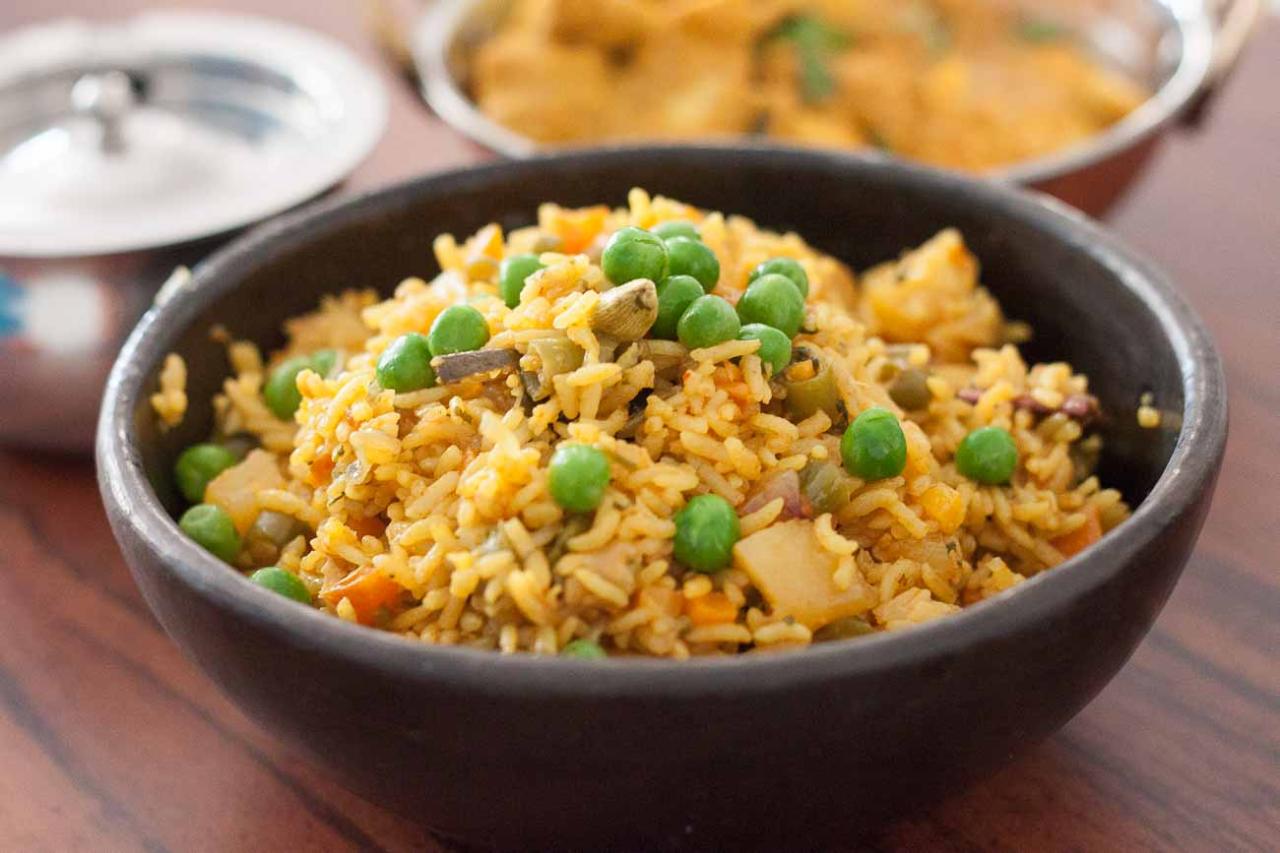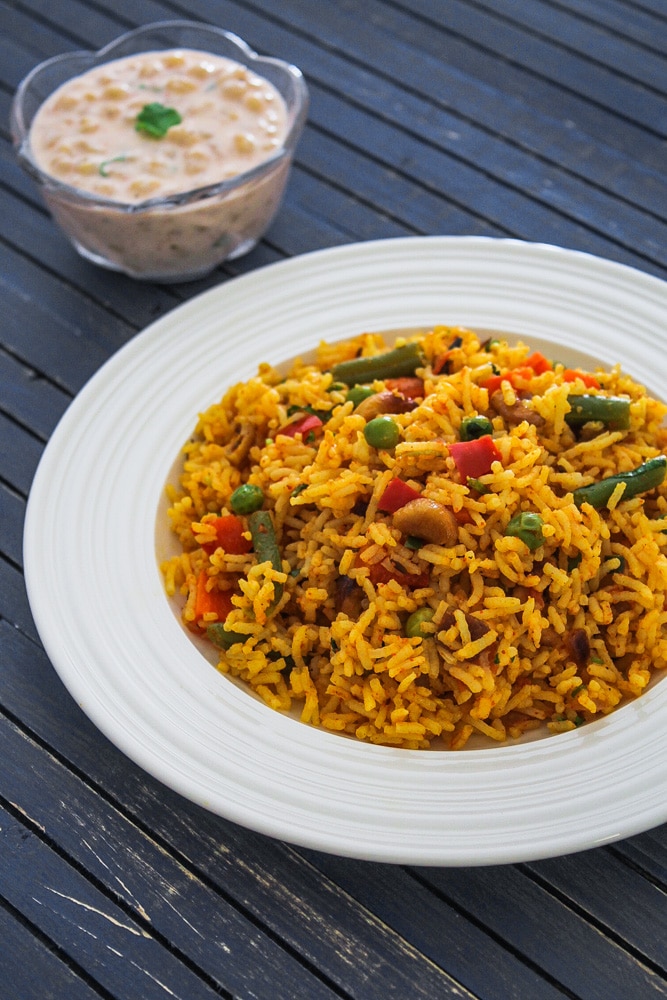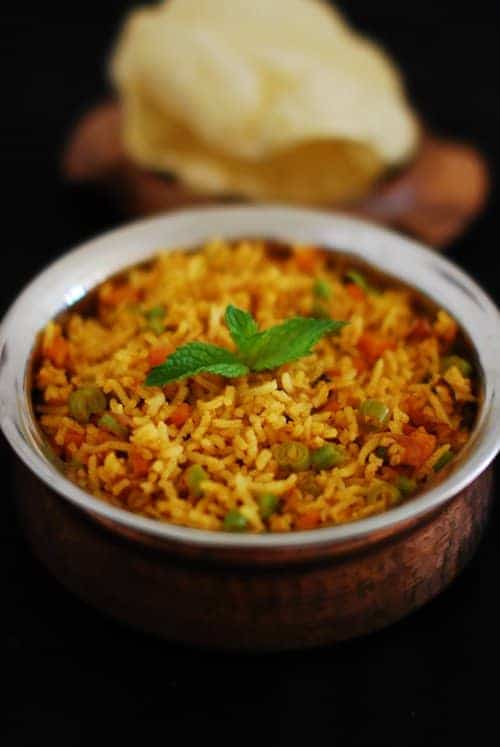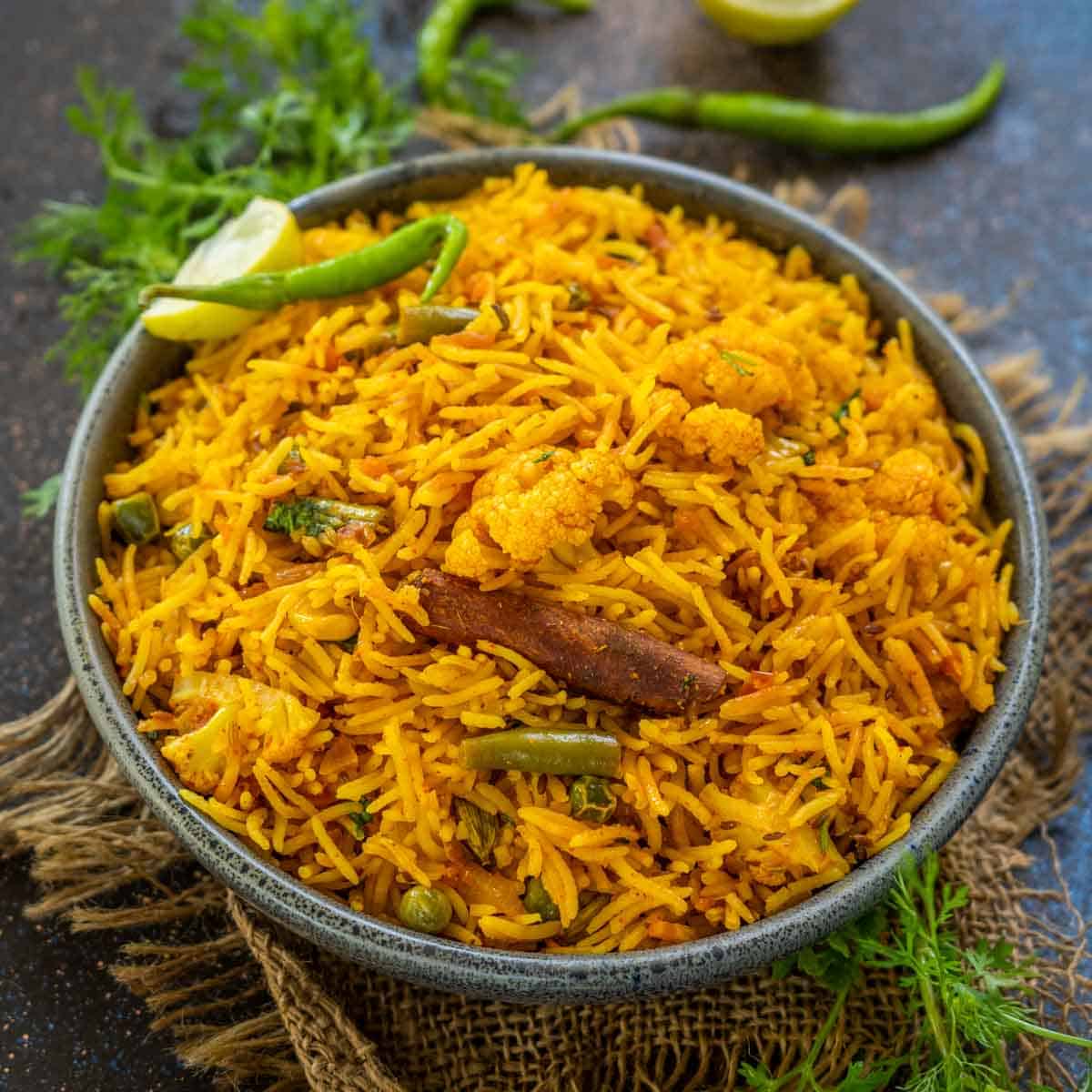Embarking on a culinary odyssey across the rich tapestry of Indian cuisine, we find ourselves in the heart of Tamil Nadu, where the scent of tempered spices and fragrant rice beckons. Chettinadu Vegetable Biryani stands as a magnificent pillar of South Indian gastronomy, hailing from the kitchens of the celebrated Chettiar community. This dish isn’t merely a meal; it’s a grand narrative of heritage and flavor woven into each layer of rice and vegetable.
As we unfurl the essence of Chettinadu cuisine, the Vegetable Biryani reveals itself as a harmonious symphony of bold spices, such as star anise, cinnamon, cardamom, and cloves, which are integral to its unique taste. The hallmark of this biryani lies in its masterful use of freshly ground masalas that imbue the vegetables with an unparalleled depth of flavor. The result is glossy, fragrant grains of rice, each encapsulating the essence of the spices, while tender vegetables nestle within, offering a mélange of textures.
Chettinadu Vegetable Biryani Recipe


Chettinadu Vegetable Biryani
Equipment
- 1 large skillet
Ingredients
- 3 tablespoons vegetable or corn oil
- 1 dried bay leaf
- 1 1-inch cinnamon stick
- 2 green cardamom pods
- 3 whole cloves
- 1 kapok bud
- 1 small piece black stone flower
- 1 star anise
- 1 cup finely chopped onion
- 1 tablespoon ginger-garlic paste
- 2 green chiles slit lengthwise
- 1 Roma tomato finely chopped
- 20 fresh mint leaves
- 1/4 cup finely chopped fresh cilantro
- 2 cups mixed vegetables such as cauliflower, peas, potatoes, beans, and carrots
- 1 tablespoon salt
- 1/2 teaspoon red chile powder
- 11/2 teaspoons ground coriander
- 1/8 teaspoon ground turmeric
- 2 cups water
- 11/2 cups seeraga samba rice rinsed in cool water, drained, soaked in water for 30 minutes, drained
Instructions
- In a large skillet or kadai over medium heat, heat the vegetable oil.
- Reduce the heat to low and add the bay leaf, cinnamon, cardamom, cloves, kapok bud, black stone flower, and star anise. Cook for 30 seconds.
- Add the onion, ginger-garlic paste, and green chiles. Sauté for 5 minutes, or until the onion is translucent.
- Add the tomato, mint, and cilantro and cook for 3 minutes.
- Add the mixed vegetables, salt, chile powder, coriander, and turmeric. Cover the skillet and cook for 2 minutes. Increase the heat to medium-high, and add the water. Bring the mixture to a rolling boil.
- Add the rice, reduce the heat to medium, and cook for 5 minutes.
- Reduce the heat to low, cover the skillet, and cook for 10 to 12 minutes, until the rice is steamed and the water is absorbed. Turn off the heat.
- Let sit, covered, for 5 minutes. Use a fork to fluff the rice. Mix gently to combine.
Notes
Cooking Tips about Chettinadu Vegetable Biryani

- Rice Selection: Choose long-grained rice like Basmati for that perfect fluffiness and to ensure each grain stands out. It also absorbs the spices well, contributing to the overall aroma of the biryani.
- Vegetable Prep: Select fresh vegetables that hold their shape and texture upon cooking such as carrots, beans, cauliflower, peas, and potatoes. Make sure they’re all cut to roughly the same size for even cooking.
- Spice Blend: The soul of Chettinadu biryani lies in its freshly ground masala. Coriander seeds, cumin, fennel seeds, star anise, cardamom, cloves, and cinnamon – either lightly roasted and ground, or used whole if you prefer a milder biryani.
- Marination: Coat your vegetables in yogurt mixed with part of the spice blend and let them marinate for at least an hour. This process allows the flavors to permeate through the vegetables, deepening the flavor profile of the biryani.
- Layering Technique: Biryani is all about layers. Alternate between layers of rice and marinated vegetables. This ensures that every bite is infused with a symphony of flavors.
- Cooking the Rice: The rice should be parboiled to 70-80% doneness before layering. This prevents it from becoming mushy when it’s steamed along with the vegetables.
- Sautéing the Aromatics: Begin by frying onions until golden brown. Add ginger, garlic, chilies, and the whole spices to infuse the oil with a bouquet of fragrances that will carry through the entire dish.
- The Right Cookware: Use a heavy-bottomed pot or a traditional ‘handi’ to evenly distribute heat and prevent burning. A well-sealed lid (or dough-sealed) is crucial for trapping steam and flavor.
- Low and Slow Cooking: Patience is key. Cook the biryani on low heat to allow the rice to steam thoroughly, enabling the spices to meld beautifully with the other ingredients.
- Final Touches: Garnish with fried onions, chopped mint, and coriander leaves to add freshness and texture. Squeeze a bit of lemon juice over the top for some added zing.
Serving suggestions about Chettinadu Vegetable Biryani

- Raita: A side of raita crafted from beaten yogurt mixed with raw vegetables such as cucumber, tomato, onion, and flavored with spices like roasted cumin powder and black salt can provide a refreshing contrast to the spiciness of the biryani.
- Pachadi: This South Indian version of raita often includes ingredients like pineapple, beetroot, or pumpkin, adding a sweet element that balances the robust flavors of the biryani.
- Mirchi Ka Salan: A Hyderabadi delicacy made of long green chilies in a sesame-peanut gravy complements the biryani well with its creamy texture and nutty flavor.
- Papad: Crispy papadams or appalams served on the side offer a delightful crunch that pairs well with the softness of the rice and vegetables.
- Pickles: A small serving of spicy Indian pickles, known for their potent flavors, can act as an appetizer and accentuate the richness of the biryani.
- Eggplant Gravy: A tangy gravy made with eggplants, often referred to as ‘Brinjal Curry’ or ‘Kathirikai Pachadi,’ is a traditional accompaniment that can enrich your biryani meal.
- Boiled Egg: Sliced or halved boiled eggs are a simple addition that can complement the vegetable-forward dish with a boost of protein.
- Roasted Cashews: Garnish the biryani with roasted cashews for an added crunch and rich flavor that melds seamlessly with the spices.
- Plain Basmati Rice: Some might enjoy having plain steamed basmati rice on the side to alternate with the spiced biryani, providing a break from the spices.
Top 5 FAQs about Chettinadu Vegetable Biryani

- What are the key spices used in Chettinadu Vegetable Biryani? The unique taste of Chettinadu Vegetable Biryani comes from the use of a blend of spices including star anise, fennel seeds, cinnamon sticks, cloves, bay leaves, cardamom, and nutmeg. It also includes ground spices such as coriander powder, cumin powder, and red chili powder. More specific to Chettinad cuisine, black stone flower, and kalpasi might also be used.
- Which vegetables are commonly included in this biryani? Common vegetables used in this dish include carrots, beans, green peas, cauliflower, and potatoes. However, chefs might also add other vegetables like bell peppers, mushrooms, or even paneer (cottage cheese) to introduce different textures and flavors.
- How is the rice prepared in Chettinadu Vegetable Biryani? The rice is typically basmati rice, known for its long grains and fragrance. It is washed and drained, then often partially cooked separately before being layered with the vegetable and spice mixture. This partial cooking is important to maintain the integrity of each grain of rice after the dish is fully cooked.
- What is the cooking technique for Chettinadu Biryani? Chettinadu Vegetable Biryani is cooked using a method called ‘Dum’, where the prepared vegetables and partially cooked rice are layered in a heavy-bottomed pot. The pot is then sealed with a lid or dough to trap the steam, and the biryani is cooked on a low flame. This slow-cooking method allows flavors to blend and penetrate the rice and vegetables.
- Can Chettinadu Vegetable Biryani be made vegan? Yes, Chettinadu Vegetable Biryani can easily be adapted for a vegan diet by ensuring that no ghee (clarified butter) or other dairy products are used. Vegetable oil or vegan butter can serve as substitutes to keep the dish dairy-free.
Chettinadu Vegetable Biryani stands as a testament to the rich and diverse tapestry of Indian cuisine, specifically showcasing the culinary brilliance of the Chettinad region of Tamil Nadu. Its preparation is a loving homage to the art of spice blending, attention to detail, and patience that defines South Indian gastronomy. Each spoonful of this aromatic delicacy unfurls layers of flavor, thanks to the harmonious symphony of bold spices, such as star anise, cinnamon, cardamom, and cloves, which are freshly ground to create the masala that deeply infuses the vegetables and rice.

Leave a Reply